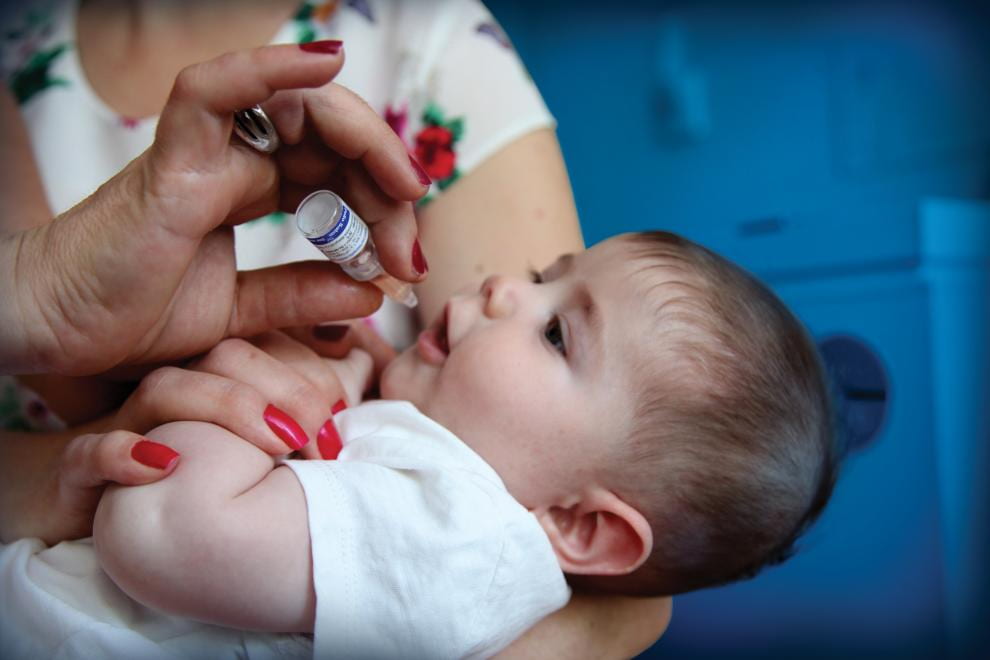
by aed05 | Nov 20, 2023 | Dashboard, Visualization
In 2020, Lebanon witnessed a substantial decrease in the percentage of immunization against Diphtheria, Pertussis, and Tetanus (DPT), Hepatitis B (HepB3), and measles among children aged 12-23 months. After more than ten years of stability, the immunization rate dropped to 67% in 2021, marking its lowest point in recent history.
Standing Out in a Global Context of Decline:
While middle-income and low-income countries experienced a decrease in immunization percentages in 2019 and 2020, Lebanon stood out with the most significant decline. Comparatively, when pitted against low-income, middle-income, and high-income countries, Lebanon witnessed the highest decrease in the percentages of DPT, Measles, and HepB3 immunization during these pivotal years.
This raises crucial questions about the specific factors contributing to Lebanon’s distinct challenges in maintaining essential childhood vaccination rates.
Economic Struggles Impacting children Immunization:
In 2019, Lebanon experienced a significant economic crisis, resulting in widespread job losses, with the unemployment rate reaching 13% by 2020. The cost of everyday items surged, approximately 85%, creating substantial challenges for individuals to afford medical expenses and seek necessary healthcare. Accessing healthcare has now become a luxury for many citizens, including children, as parents prioritize essential goods over vaccinations for their kids.
In addition, the Lebanese government allocated similar resources in Lebanese Lira to its healthcare system in 2019 and 2020 as it did in 2018. However, the impact of inflation eroded the purchasing power, diminishing the effectiveness of the government’s support, especially given that healthcare costs are often priced in US dollars.
Shielding the Health of the Lebanese :
In the world public health, the ramifications of low vaccination rates against DPT , Measles and HepB3 are far-reaching and dire. The repercussions extend from the heightened risk of individual health issues to the vulnerability of entire communities facing outbreaks. These outbreaks not only strain healthcare systems but also impose a substantial economic burden, creating a global health threat. The gravity of these consequences becomes most evident in the specter of preventable deaths looming over communities.
Recognizing the gravity of these consequences, urgent action is essential. The government must increase its investment in vaccination programs, ensuring free and universal accessibility. It should collaborate with international entities such as World Health Organization and NGOs to get financial support.
These efforts will not only promote individual well-being but also strengthen the communal defense against potential outbreaks, paving the way for a healthier and safer future for all.

by sgn09 | Nov 19, 2023 | Dashboard
HIV persists as a noteworthy communicable disease in Europe and a substantial risk in the Arab world, posing a significant health challenge. This infection is associated with considerable healthcare costs for treatment and care, a noteworthy mortality rate, and a reduction in life expectancy. The virus specifically attacks the immune system, resulting in a persistent and severe illness with an extended incubation period before symptoms manifest.
The average prevalence from 2005 to 2021 reveals notable trends. While some Arab countries, like Saudi Arabia, UAE, and Iraq, do not consistently report HIV statistics, the available data highlights the prevalence of the disease in Arab countries situated in Africa. In contrast, European countries, particularly Portugal, Latvia, France, and Italy, exhibit higher prevalence rates.
Within the Arab world, there is an upward trend in the percentage of HIV incidences in Yemen, Algeria, Qatar, and Tunisia. Conversely, Djibouti, Mauritania, Morocco, Comoros, Sudan, and Libya exhibit a decline in HIV incidence rates.
Within the Euro area, there is an increase in HIV incidences observed in Slovakia, Latvia, Bulgaria, Greece, Lithuania, and Ireland. However, a decrease is noted in the Netherlands, Italy, Slovenia, Portugal, Denmark, France, Luxembourg, Spain, and Croatia.
HIV prevalence is higher in European Union countries compared to Arab countries. There was an incline in Arab countries around 2020, while in the European Union, the trend experienced a decrease in 2017, followed by a slight upward movement.
We will be focusing on these countries in the following visuals.
Most countries do not report parameters related to children living with HIV and newly infected children. However, the available data indicates that in Algeria and Morocco, both the number of children infected and the number of new cases are on the rise. In contrast, Djibouti has successfully decreased these numbers, as has Mauritania.
In our selected focus countries, notable instances of HIV infection among the female population are observed. Within Arab countries, Djibouti, Comoros, Mauritania, Sudan, Morocco, Algeria, and Tunisia exhibit a high prevalence. Similarly, in EU countries, France, Portugal, Latvia, Ireland, Luxembourg, and Italy show a high number of females infected with HIV.
Antiretroviral therapy coverage has seen an increase since 2005 in Djibouti, Mauritania, and Morocco within the Arab world, as well as in Latvia and Bulgaria. The effectiveness of the treatment is reflected in the declining incidence cases observed. However, in Algeria, despite an increase in treatment coverage, the number of incidents continues to rise. A similar situation is noted in Slovenia, suggesting that the treatment alone may not be sufficient to curb the spread of HIV.
Information pertaining to condom use and protected sex is currently unavailable, emphasizing the need to gather this specific dataset.
In conclusion, Europe & the Arab World are far from meeting global HIV targets. Annual new HIV infections from AIDS-related illness are on the rise. While treatment can contribute to reducing the prevalence of HIV in a country, it is just one aspect of a comprehensive approach. Relying solely on treatment is inadequate. Nations should prioritize addressing other impactful factors, including:
- Implementing prevention programs that effectively reach key populations in substantial numbers.
- Making special efforts to enhance and extend HIV testing and treatment initiatives.
- Increasing engagement with the younger demographic.
- Enforcing effective policies such as mandatory testing for work or residence permits, mandatory testing for marriage, and criminalizing activities such as sex work and drug use or possession for personal use.

by iaa28 | Nov 23, 2022 | Uncategorized
Public health is linked to the economic strength of a country as health expenditure is positively associated with the productivity and GDP of a nation. The advances and improvement of many of the main forces driving economic growth over time span such as technological progress, education, and physical capital accumulation contribute to the improvement of health services in countries. However, with the world divided between first, second and third world countries, public health situation differs between economically strong and weak countries.
COVID-19, as a recent event, shed light on the differences in health systems within the Arab world, especially that the region includes some of the richest oil producing countries as well as poor and war-torn countries.
The below graph visually views the differences between the GDP of the Arab League Countries in the Year 2019. For example, at the top of the GDP scale , we have Qatar, a relatively geographically small GCC country and biggest producer of natural gas, has a GDP of $175 billion which is more than GDP of Libya, Lebanon, Sudan and Yemen combined.
The size of a country’s GDP determines the monetary value of its health expenditure as a percentage of GDP. Comparing the GDP tree map with Health Expenditure graph below , we can see that countries with high GDP (e.g, Qatar, UAE) shows small percentage of health expenditure while Countries with low GDP (e.g, Lebanon, Jordan) shows larger percentage of health expenditure.
In monetary terms, Lebanon has a highest total health expenditure % in the Arab World which amounts to 8.64%($51.6 B)= $4.45 billion. On the other hand, Qatar has a low health expenditure % of 2.9 but when multiplied by the country’s GDP, it amounts to 2.9%($175 B)= $5 billion.
Health Expenditure per capita shows the direct impact of GDP of a country on its health spending. As shown in the below graph, countries with high GDP have high health expenditure compared countries with low GDPs.
The above discussion pointed out the relationship between the strength of a country’s economy and its health spending. The question that remains is “How does this reflect on the health of people?”
Diseases
Countries that allocate large budgets for the development of the health sector and public health perform well in the face of diseases, especially communicable diseases and pandemics such as COVID-19. The below bubble chart shows that countries with low GDP have the highest percentage of deaths by communicable diseases.
Life Expectancy and Death Rate
To further show the evidence of the impact of GDP and public health spending, we consider both indicators: Life Expectancy at Birth and Death Rate in the Arab League Countries.
- Life Expectancy at Birth: we can that people from countries with high GDPs and high health expenditure per capita. Qatar leads the way with 80 years expected age in 2020 while Yemen has an expected age of 66 years in the same year.
- Death Rate: the same pattern seen with Life Expectancy is also seen in death rates per 1000 persons. Qatar has a death rate of 1.2 compared to Yemen which has a death rate of 5.9, both in 2020.
What should be done?
The United Nations Sustainable Development Goal #3 “Ensure healthy lives and promote well-being for all at all ages” points out the need for improving the public health of the world population. Health spending by governments is a very important factor in the health of their people. However, for those countries who are economically disadvantaged, improving health can be also achieved through:
- Investing in education, especially in medicine studies to make sure the health sector has the competent doctors and specialists.
- Directing international aid more towards developing health sectors in poor countries rather than urgent assistance.
- Investing in awareness: one of the most important ways to improve health in developing countries is by educating citizens to take preventive healthcare measures and avoid riskier health behaviors.

by hrp00 | Nov 22, 2022 | Uncategorized
The mortality rate in Africa countries is very high compared to other countries worldwide. One cause of the mortality rate is the unintentional poisoning especially children. Because of the high poverty rate, low access to water, and high literacy rate, people are not much aware of the importance of hygenie and sanitation. This is causing a high mortality rate due to the unsafe water, sanitation and lack of hygiene. There is lot of unintentional poisoning cases in Africa compared to other countries in different continents. The problem is very serious and needs immediate response since its contribution to the overall mortality rate is high.
A response of the addressed problem is curing the poisoned case; however, the capacity in hospitals is low as the number of beds per 1000 persons is very low. Therefore, we are looking forward to solve the root problem and not only react to it. So, a good solution for the addressed problem is to increase awareness of how to avoid poisoning especially at home by the government, or related parties.
The awarness should takle these three aspects:
-How to clean food (vegetables, fruits) at home
-Filtering water with basic tools
-Right way of taking a medicine and storing it
-Right way to use chemicals or detergents and keep them away from children
More than 90% of poisoning cases are occurring at home. Therefore, starting to spread awareness of how to avoid getting poisoned at home might reduce the unintentional poisoning that is causing death. Thus, we are decreasing the mortality rate.
It’s true that we want to solve the problem from its base; however, we should also know how to provide good care and treatment for a poisoned case. This should be teached to people as first aid sessions to be eligible to approach a case and prevent the deterioration of his health or death.

by aia39 | Nov 22, 2022 | Dashboard, Visualization
Ensure healthy lives and promote well-being for all at all ages GOAL:3
On the morning of his 45th birthday, Pedro woke up feeling depressed and anxious what was supposedly a happy occasion was one step closer to inevitable death for Pedro. You see no one in Pedro’s family has ever surpassed the age of 50 to think of it Pedro doesn’t know anyone who has lived above 50 in Mozambique. as Pedro went into the
kitchen to see his three children and wife who had prepared a lovely breakfast for this day. The thought that in a few years he won’t be able to be next to his loved ones ever again broke his heart no father wishes to leave his children.
Mozambique is one of many countries that suffer from low life expectancy at birth due to poor healthcare in the country. Even if the treatment was availableit would be extremely expensive. The average person who lives in Mozambique like Pedro couldn’t afford treatment when needed. All over the country, people are dying early because treatment for simple diseases is not easily accessible.
This tragic occurrence leads to the early death of many people. Like Pedro, there are thousands of people who pray that the government will establish an effective well-trained healthcare system that is also affordable and accessible to everyone in the country.
A proper healthcare system will extend the lives of people like Pedro who wish to stay next to their loved ones for years to come without fear of death at an early age. For a health system to be truly effective it needs to be adequately supervised by the government along hiring trained professionals to ensure the success of the system.
strong regulations and close observation by governments are required so that hospitals and pharmacies don’t take advantage of the people.
If proper healthcare is made accessible to people, health expenditure will increase leading to an increase in life expectancy.
Everyone deserves to live a long healthy life!

In year 2000 we can see that the life expectancy at birth was an average of 48.95 years back then the current health expenditure(%of GDP) was on average 2.26

In year 2019 Mozambique Current health expenditure (%of GDP) became an average of 7.83 and obviously the life expectancy at birth increased to 60.85 years
PROBLEM: The lack of proper healthcare Leeds to Low life expectancy in less developed countries this means that people are dying at early ages Because they do not get access to early diagnosis ,timely treatments and resources to treat the disease.
PROBLEM EVIDENCE :Life expectancy depends on variables that are related to healthcare resources it is obvious That if we look at the current health expenditure(%GDP) that represents the level of resources c
hanneled to health relative uses of the different countries we can see that countries who spend less on health expenditure have a lower life expectancy and vice versa.
POTENTIAL SOLUTION: Proper access to healthcare is associated with lo
w risks of mortality meaning higher life expectancy. Providing access to healthcare and making prices of medication affordable is essential also it is important to focus on patient engagement and connection in order to treat the patient better
SOLUTION DETAILS:Government should work on lowering prices of prescription drugs so that they can be accessible to people who need them. Government must preserve the interests of its citizens by supplem
enting the market where there are gaps and regulate markets to improve efficiency and illuminate any unfairnessin the health sector this will require strong regulations and close observation by governments
SOLUTION VALIDATION:Through the graphs we can see valid evidence that countries that spend more on current healthcare expenditure tend to have higher life expectancy for example In Mozambique in year 2000 we can see that the life expectancy at birth was an average of 48.95 years back then the current health expenditure(%of GDP) was on average 2.26 when the current health expenditure started increasing so did the life expectancy in year 2019 Mozambique Current health expenditure (%of GDP) became an average of 7.83 and obviously the life expectancy at birth increased to 60.85 years meaning that The life expectancy improved 11.9 years this was also the case in a lot of other countries
RECOMMENDATION: For this to be possible it is recommended to recruit train and produce rise health workers because they are the heart of any strong healthcare system also establish affective surveillance on the healthcare industry (pharmacies and hospitals) by improving access to affordable Stable inclusive treatments






